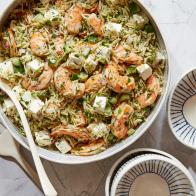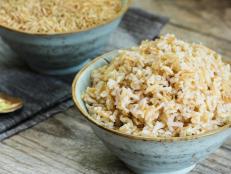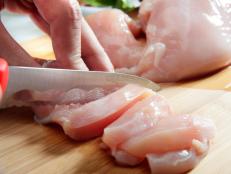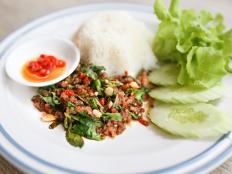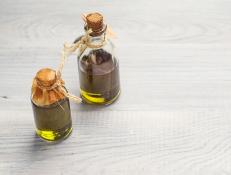Is It Safe to Eat Leftover Rice?
Yes, if you follow a few simple guidelines.

Johner Images/Getty Images
When cooking at home regularly, it makes sense to cook in bulk. This is especially true for foods that you eat all the time, like rice. However, there’s a misconception that it’s not safe to reheat leftover rice. To ensure that the leftover rice you’re eating is safe, just make sure that you cook, cool, store and reheat it properly in order to prevent illness and food waste. Here are guidelines to follow to make your rice last as long as possible.
How Can Rice Make You Sick?
You may have heard on social media or elsewhere that cooked rice that is left for a few hours becomes contaminated with bacteria and can lead to food poisoning if eaten. This is only partially true – so let’s fill in the blanks!
Uncooked rice may contain bacteria called Bacillus cereus — and yes, if you consume a large amount of these bacteria it can potentially make you sick. If the rice is cooked to the proper temperature (at least 140 degrees Fahrenheit), the harmful bacteria will be destroyed. If you cool and store it quickly and reheat properly — even two or three times — you should be just fine.
Do avoid letting your rice sit in your kitchen at room temperature for hours at a time as it can potentially make you sick.
Below you’ll find more information on how to safely handle rice through proper cooking, serving, cooling — and yes, even reheating.
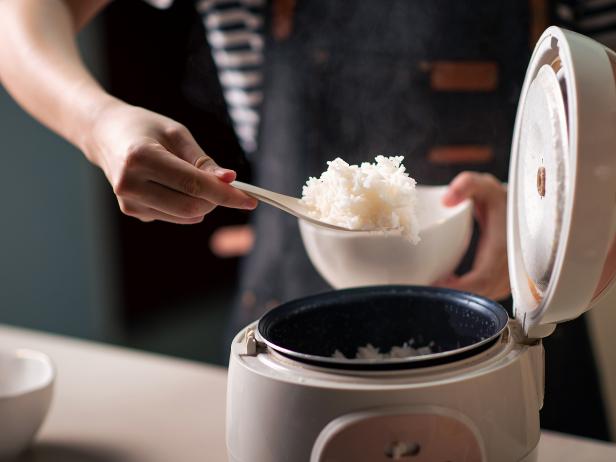
Stefan Tomic/Getty Images
How to Cook Rice
The first step to cooking in the kitchen is washing your hands properly with soap and water. Next, cook rice according to the package directions. This means bringing the rice to a boil, which is done in order to destroy any pathogenic microorganisms that may be present, including Bacillus cereus.
If you’re rinsing rice for food safety purposes, there are no guidelines that indicate that this will make it safer to eat. In addition, some folks rinse rice or soak it overnight before cooking in order to remove some of the starch that causes it to become gummy when cooking. While this isn't necessarily a problem culinarily speaking, according to the Food and Drug Administration (FDA), rinsing or soaking white or parboiled rice may also reduce some of the nutrients added as part of the enrichment process like folate, iron, niacin and thiamin, by 50 to 70 percent.
If you choose to use a rice cooker at home, cook it in the appliance but just make sure that the temperature reaches and stays at 140 degrees Fahrenheit or above in order to continue safely storing rice inside it. If you’re unsure, remove the rice after it is done cooking, cool it properly using the guidelines below and keep it in the refrigerator.

Alexander Spatari/Getty Images
How to Serve Rice
How long your rice sits out when you serve it also plays a role in its safety. Bacteria grows rapidly in temperatures between 40 degrees Fahrenheit and 140 degrees Fahrenheit. After your rice is safely cooked, it should be kept hot (at 140 degrees Fahrenheit or above) in order to prevent bacterial growth. If you’re serving the rice and place it in a bowl on your table at room temperature, then it must be refrigerated within two hours of cooking. If the rice sits out for two hours at room temperature or one hour if the temperature is 90 degrees Fahrenheit or above (like eating outdoors), then the rice should be tossed.
In order to avoid leaving your rice out for too long, serve a small batch of it for the meal and cool the rest of the batch to room temperature (for about 20 minutes). Then immediately pack in a container and refrigerate it.
How to Cool Rice Properly
In order to prevent bacteria growth, store rice at 40 degrees Fahrenheit or below, which is the typical temperature of a refrigerator. Never place hot rice (or any food) in your refrigerator as it can increase the temperature of the surrounding foods, placing them all at risk for bacterial growth.
To cool rice quickly, divide large batches of rice into smaller batches by placing it in shallow containers. Once the food reaches 70 degrees Fahrenheit, a.k.a. room temperature, cover the container and then place it into the refrigerator or freezer.
Cooled rice should be placed in a re-sealable bag or covered storage container. This helps keep bacteria out, retains moisture and prevents odors from being picked up by the rice. Don’t forget to label your food with the name and the date you should use it by. According to the FoodSafety.gov FoodKeeper App, leftover rice can be stored in the refrigerator for three to four days, and in the freezer for one to two months.
How to Reheat Rice Safely
You can absolutely reheat leftover rice as long as you have handled it properly — and followed the guidelines above. If you stored your rice in the freezer, then it’s important to thaw it properly. You can thaw it in the microwave and heat it until it reaches 165 degrees Fahrenheit when measured with a food thermometer. You can also place frozen cooked rice in the refrigerator overnight to thaw. Thawed rice can be used for between three to four days but still needs to be heated before you eat it.
If it is a smaller portion of rice, you can also reheat frozen rice without thawing by placing it in a saucepan with a splash of liquid (like water or broth) or a few ice cubes. As long as you reheat it quickly (in less than two hours), this method is safe.
Reheated rice, no matter which method you use, should reach 165 degrees Fahrenheit.
If refrigerated leftovers were reheated to 165 degrees Fahrenheit and proper guidelines were followed, the leftovers can still be placed in the refrigerator and reused again within the three to four days of when it was originally refrigerated.
Bottom Line: Understanding why food safety issues happen and following the recommended guidelines can help keep your food safe — including rice.
Toby Amidor, MS, RD, CDN, is a registered dietitian and consultant who specializes in food safety and culinary nutrition. She is the author of The Greek Yogurt Kitchen: More Than 130 Delicious, Healthy Recipes for Every Meal of the Day.
*This article was written and/or reviewed by an independent registered dietitian nutritionist.
Related Content:
